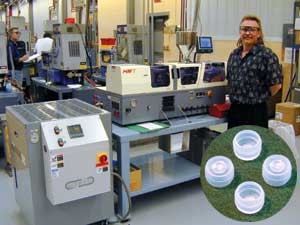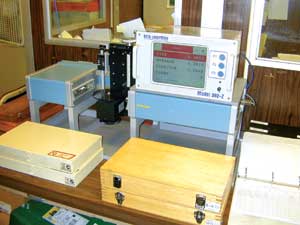A big closure molder's thinking small
Caplug's Mark Sporysz says the volume and quality requirements for tiny protective plugs (inset) led to the recent purchase of the company's smallest press ever, and a multicavity hot runner mold to run in it.
August 20, 2002
|
Caplug's Mark Sporysz says the volume and quality requirements for tiny protective plugs (inset) led to the recent purchase of the company's smallest press ever, and a multicavity hot runner mold to run in it. |
IMM recently ran an article about a rather unusual new tooling product from Polyshot Corp. (West Henrietta, NT)—a little hot runner mold designed for a 7-ton tabletop molding press (see "Hot Runner Micromolding," May 2002 IMM, p. 58). You might have wondered who would have commissioned such an unusual little product, and why. We did, too.
As it turns out, it was originally designed for Caplugs, one of the largest U.S. suppliers of molded closures. Privately held with $34 million in sales and ISO 9001/QS 9000/AS 9000 certified, Caplugs has been a major player in the protection products market since 1948.
Says Mark Sporysz, design engineer, "We mold more than a billion parts a year for 20,000 customers. We have more than 165 million parts ready to ship every day. For us, run sizes range from 5000 to more than 5 million."
The demand for the 5 million parts Caplugs runs on its new 7-tonner, a model HM7 from Nissei America Inc. (Anaheim, CA), certainly fits the bill. They are tiny LDPE bearing retainer plugs for rocker arms with no room on them for a gate vestige. They have a ±.002-inch OD tolerance specification, but the company is molding to within ±.0005 inch. Caplugs runs them in the eight-cavity Polyshot runnerless mold for one of its customers.
The molder had never run such a small machine before, never mind one running such an unusual mold. But when Caplugs makes a commitment to a customer, it keeps it.
|
An optical laser measuring system ensures that Caplugs is holding the key dimensions on the LDPE small rolling hole plugs to within specified tolerance. |
A Helping Hand
It may have never run such a small press before, but Caplugs knows how to mold. It has 64 molding machines up to 400 tons. Caplugs builds its own molds, too. It has about 3000 injection tools. But the bearing project was different from anything Caplugs had ever encountered, according to Sporysz.
"Most machines are over capacity for this kind of part," he explains. "Their barrels are not set up for parts this size. That's why we went with the HM7. Our sister company is Mokon [Buffalo, NY]. We put a 1-ton Mokon thermolator on the HM7. Think Mokon gave us a special deal? No way."
Caplugs sent the HM7 over to Polyshot. "The design went back and forth a few times. The mold was a little too wide when it was done, but we made the modifications ourselves."
Sporysz says the hot runner system and the HM7 have been running flawlessly so far. Time for the next job on it has already been booked.
Contact information |
About the Author(s)
You May Also Like




